In Response to @lesshorrible NSAS Idea Suggestion #12 - The Forest
Summary
This post represents a response to the suggestion of @lesshorrible in his post NSAS Idea Suggestion #12 - The Forest.
This article weaves some science and history of forests and trees with the threads of my life, from childhood to a career in plant biology, through retirement and steemit blogging (which I am still trying to learn how to do appropriately, without presenting too much data!).
Origin of My Interest in Forests and Trees
When I was growing up in Yorkshire, England my father was a policeman (a detective) and he was assigned to work in a coal-mining town called Mexborough in the late 1950's. The town was totally black from coal dust everywhere. I don't recall seeing any green ... just different tones of gray and black, like I was living in a black-and white movie. Lumps of coal would be found literally emerging from the soil. I soon learned from reading encyclopedias in the library (no internet back then!) that all this coal spewing from the ground was produced by plants in the Carboniferous period around 350 million years ago (Carboniferous Period - Encylcopedia Brittanica). Wow, for a 9-year old covered in coal dust, this was an eye-opener, and sparked my interest in plant biology.
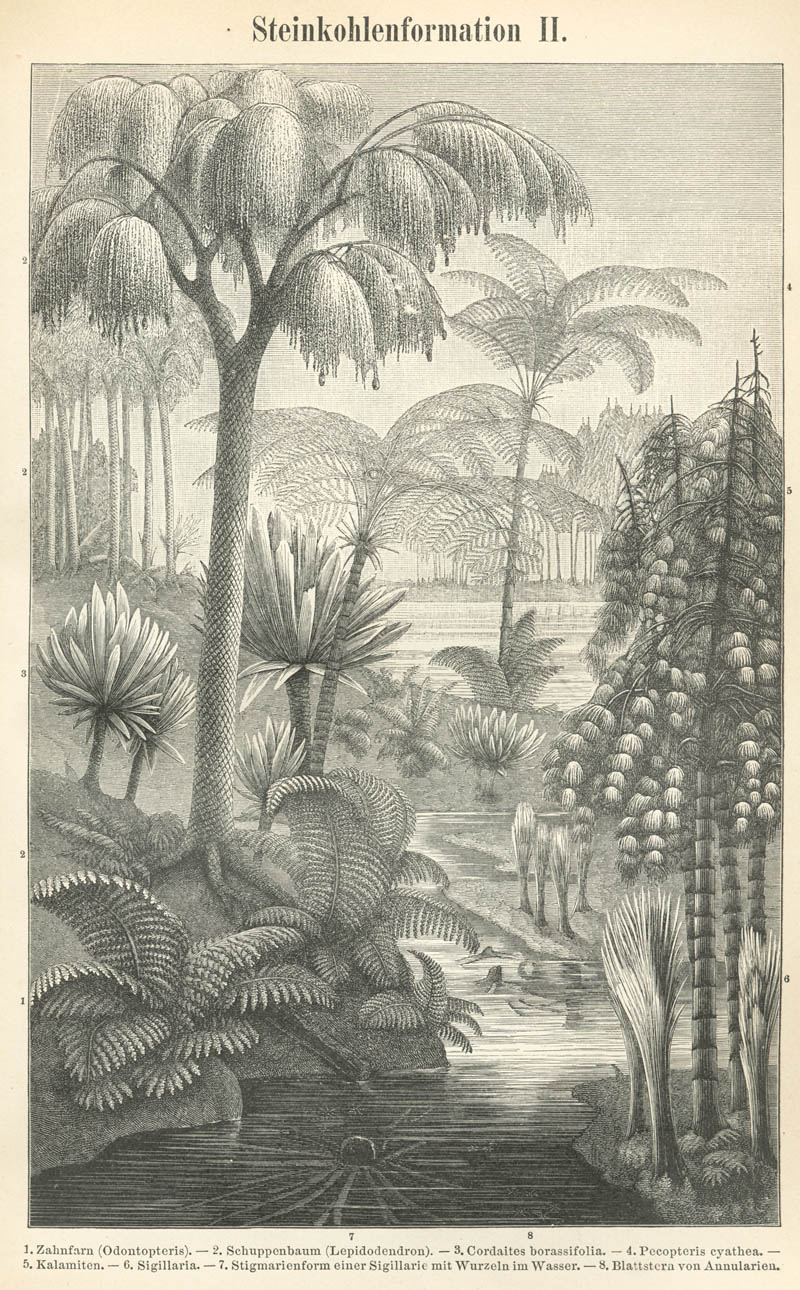
Etching depicting some of the most significant plants of the Carboniferous (Bibliographisches Institut - Meyers Konversationslexikon (1885–90)). Image Source:
I have subsequently learned that most of these deposits of coal were from primitive land plants (including lycopods, ferns and early gymnosperms) (Angiosperm Evolution). The lycopods could grow as tall as 100 feet. They must have already developed vascular tissues (xylem and phloem) at that time in order to carry water and photosynthate over vast distances within the plant. This means they would already have developed lignified cell walls (particularly in water-carrying xylem tissues) to provide mechanical strength to support these massive trunks. Little did I know that later in life I would be working alongside a colleague at Purdue University (Clint Chapple) who has elucidated the lignin biosynthesis pathway in plants and traced its origin to the Carboniferous period (Weng, J.K., Chapple, C. The origin and evolution of lignin biosynthesis. New Phytol. 187: 273-285 (2010)).
My brothers and I would go train-spotting at Mexborough train station, and this is exactly how I remember the area:

Mexborough West Junction in 1950. Image Source
The main flux of train traffic through Mexborough was coal (primitive fossil trees), and we now know that the utilization of this fossil fuel has had massive consequences on the CO2 concentration in our atmosphere:

CO2 concentrations over the last 400,000 years. Image Source:
All this CO2 released to the atmosphere was assimilated by forests of lycopods, ferns and primitive gymnosperms some 350 million years (or so) ago!
Was all the coal deposited back then unable to be broken down by fungi and bacteria? Perhaps fungi had not yet developed the enzymatic capacity to degrade lignified cell walls (lignin and cellulose polymers) of these primitive land plants? The advent of genome sequencing and molecular clock analyses have now traced the origin of lignin degrading enzymes in fungi to the end of the Carboniferous period (Floudas, D., Binder, M., Riley, R., et al. The Paleozoic origin of enzymatic lignin decomposition reconstructed from 31 fungal genomes. Science 336: 1715-1719 (2012), Hittinger, C.T. Evolution. Endless rots most beautiful. Science 336: 1649-1650 (2012)), apparently calling a sharp halt to coal deposition!
Returning to my youth, my sister became very ill as a result of all the coal dust in the Mexborough coal-mining area, and my father was urged to move to a more rural area in Yorkshire to overcome my sister's coal-dust aggrevated respiratory problems. We moved to Wetherby, and for the first time I saw green instead of shades of black! Believe it or not, that was my first exposure to trees, grass and a river (the River Wharfe)! We used to play football (soccer) in the park (King George's Field) pictured below, and boat, swim and fish for minnows in the river.
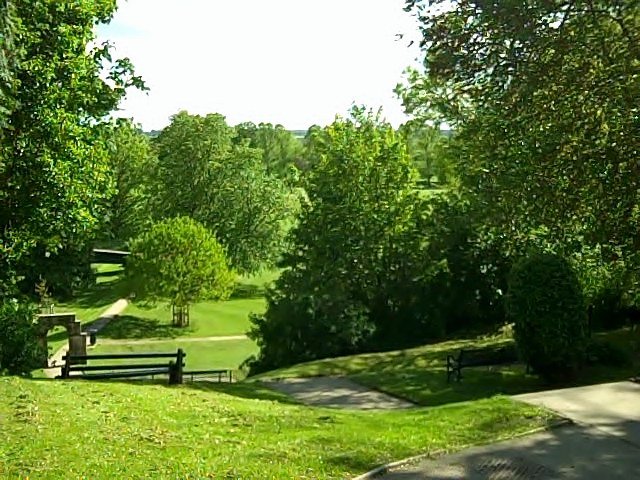
King George's Field, Wetherby (D. Rhodes)
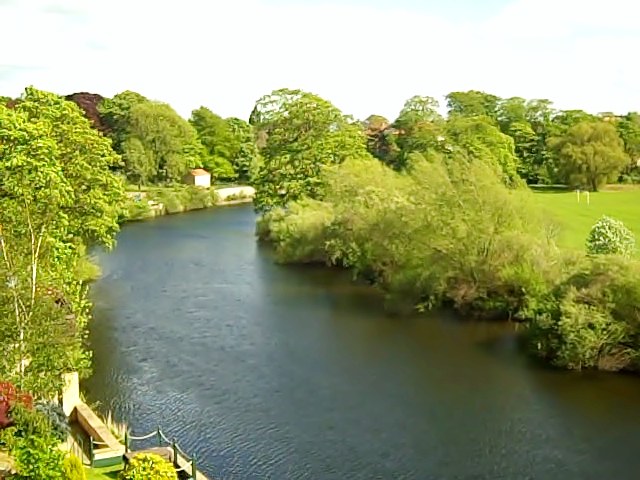
River Wharfe (Wetherby) (D. Rhodes)
From that time on, I was always fascinated by plants, trees and forests. I am particularly fond of ancient trees. One of my favorite trees in England is the ancient yew tree (Taxus baccata) behind The Parish Church of St. George in the small village of Crowhurst in East Sussex, England (A Yew-nique Tree with Historical Significance) likely planted in 700 A.D. and already 366 years old at the time that William the Conqueror invaded England in 1066.
My Favorite Forests
When I came to the USA I spent a few years in The San Francisco Bay area and was in awe at the magnificent (and ancient) coast redwoods (Sequoia sempervirens) of Muir Woods National Monument. These trees, reaching up to 110 meters in height, push the theoretical limits of transpiration in plants, having to lift water from the roots to the tree top (against the force of gravity) in order to sustain photosynthesis in the canopy (Koch, G.W., Sillett, S.C., Jennings, G.M., Davis, S.D. The limits to tree height. Nature 428: 851-844 (2004), Ambrose, A.R., Sillett, S.C., Koch, G.W., Van Pelt, R., Antoine, M.E., Dawson, T.E. Effects of height on treetop transpiration and stomatal conductance in coast redwood (Sequoia sempervirens). Tree Physiol. 30: 1260-1272 (2010)).
Sunlight shining through redwood trees at the Muir Woods National Monument. Image Source:
Sadly many of these old-growth forests have now been lost due to logging. The impact of this deforestation on the carbon budget of the planet is potentially very significant ... "Trees store close to 90% of all biomass carbon on earth (c. 500 Gt C), and this pool is not so different in size from the total amount of C in the atmosphere (750 Gt C). Atmospheric C-content is therefore sensitive to forest destruction" (Körner, C. Carbon limitation in trees. J. Ecol. 91: 4-17 (2003); see also Körner, C. Biosphere responses to CO2 enrichment. Ecological Applications 10: 1590–1619 (2000)).
I am now living in Indiana, in West Lafayette along the Wabash river. Again much of the old-growth forest has been lost from this area. A few pockets of old-growth forest remain along the Wabash river valley. Just across the border with Illinois is Beall Woods State Park with about 600 acres of old-growth forest (The Forest of the Wabash) containing a magnificent stand of white oak (Quercus alba), tulip tree (Liriodendron tulipifera), American sycamore (Platanus occidentalis), and American sweetgum (Liquidambar styraciflua) with some trees reaching 120 feet in height. The tulip tree (the state tree of Indiana) is a member of the Magnoliaceae, and is now recognized to be a "basal angiosperm" (Angiosperms - Flowering Plants - Tree of Life Web Project) which likely evolved during the Cretaceous period (Liriodendron), and thus co-existed with dinosaurs (Angiosperm Evolution).
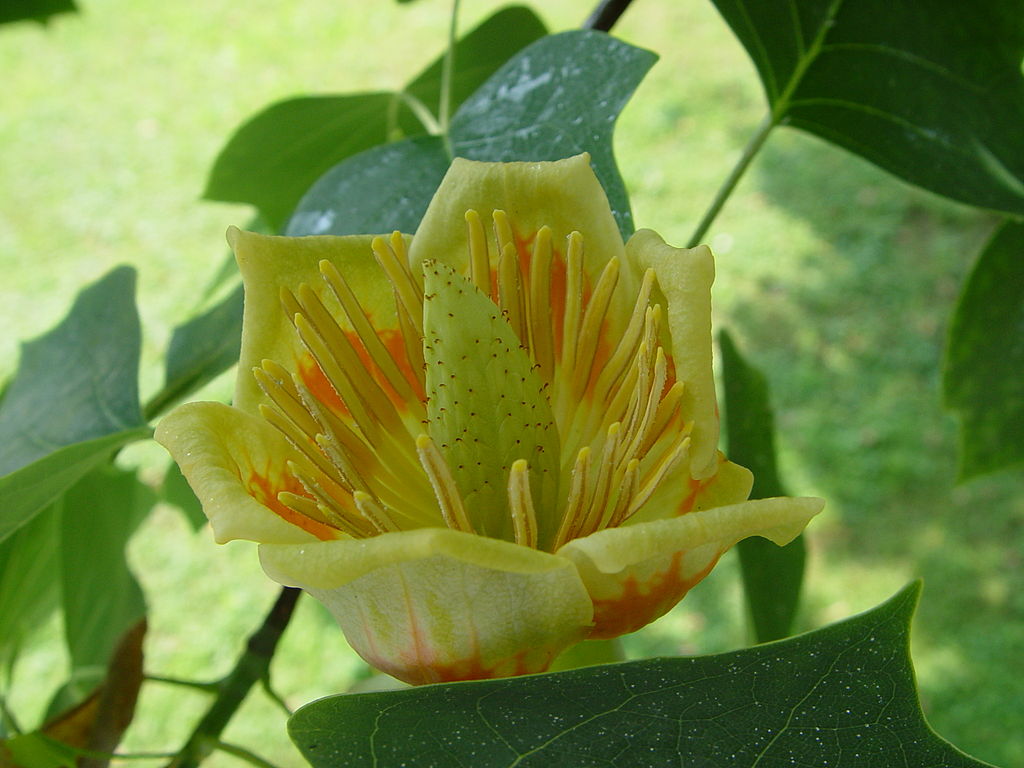
Tulip tree flower. Image Source:
My sister-in-law lives near Denver, Colorado, and we now enjoy visiting the wonderful forests of the Colorado Rocky Mountains. Here are some photos taken by myself during these visits over the last few years:
The tree-line in these mountains reaches elevations of 11,000 to 12,000 feet above sea-level (What Is the Elevation of the Timberline in Colorado?).
The low partial pressures of O2 and CO2 at these elevations, combined with low temperatures and high winds, limit the growth of trees in this region. Nevertheless ancient Rocky Mountain bristlecone pines (Pinus aristata)(reaching ages of over 4,000 years) still survive on exposed rocky slopes (Rocky Mountains subalpine zone - Wikipedia). The Bristlecone pines are extremely valuable for reconstructing past climates: their tree rings provide a detailed record of past climate (both temperature and moisture availability).
Pines (Pinaceae) are gymnosperms which probably evolved during the late Carboniferous/early Permian period around 300 million years ago. They survived both the end-Permian extinction event (250 million years ago) and the end-Cretaceous asteroid impact event (66 million years ago) that is thought to have killed off the dinosaurs (Angiosperm Evolution). Nowadays pines are threatened by fungal disease, pine beetles and increased temperatures (Bristlecone pine, Robbins J. Old trees may soon meet their match (2010)).
If you are ever in Colorado, please try to visit Florissant Fossil Beds National Monument (Florissant Fossil Beds National Monument, CO, Florissant Fossil Beds National Monument) where you can find superbly preserved fossils of many angiosperms and redwood trees dating to about 34 million years ago. The site features the largest petrified stumps of redwoods (similar to modern sequoias) in the world. It is estimated that the trees reached heights of 60 meters and (based on their tree rings) were likely 500 to 700 years old at the time of their death. The trees were killed by lahars from volcanic eruptions, starving the roots of oxygen (Meyer, H.W. The Fossils of Florissant. Smithsonian Institution Press (2003)).
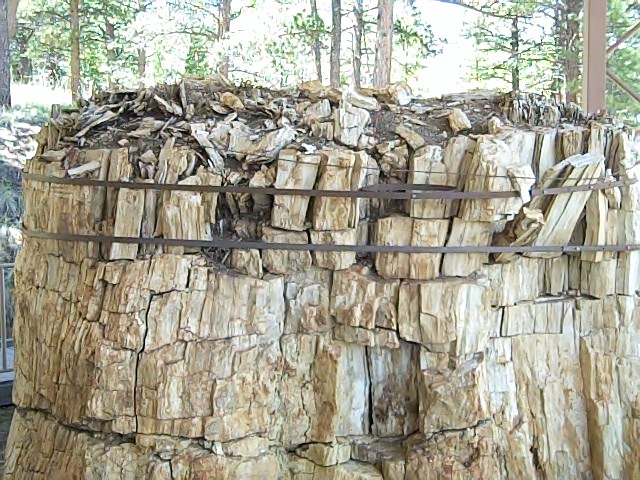
Fossil redwood stump at Florissant, CO (D. Rhodes)
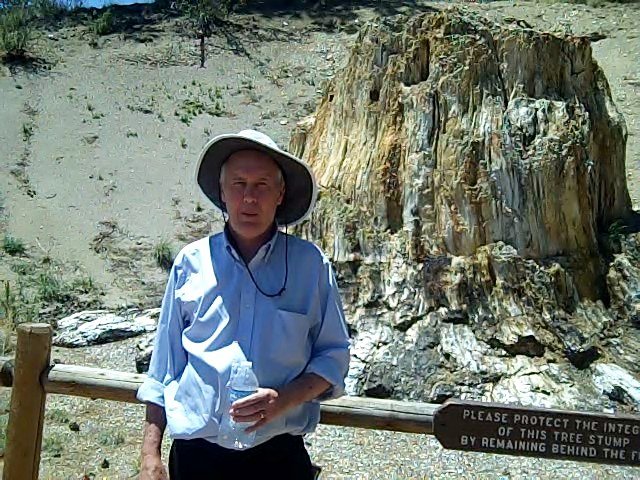
The author at Florissant, CO (D. Rhodes)
My Bucket List of Forests To Visit:
Dwarf/Pygmy Forests. Typically these forests (with miniature trees) are growth-limited by either high elevations and/or specific nutrient deficiencies in the soil.
Great Smoky Mountains. The blue (smoky) haze emanating from these forests is a gas (isoprene, and secondary organic aerosols derived from isoprene) emitted by deciduous trees (Naranjo, L. Volatile trees: Forests fill the air with more than just a fresh scent (2011), Ying, Q., Li, J., Kota, S.H. Significant contributions of isoprene to summertime secondary organic aerosol in Eastern United States. Environ. Sci. Technol. 49: 7834-7842 (2015), Jud, W., Vanzo, E., Li, Z., Ghirardo, A., Zimmer, I., Sharkey, T.D., Hansel, A., Schnitzler, J.P. Effects of heat and drought stress on post-illumination bursts of volatile organic compounds in isoprene-emitting and non-emitting poplar. Plant Cell Environ. 39: 1204-1215 (2016)).
Amazon Rainforest. Much of the phosphorus required for the lush growth of this incredible ecosystem comes from dust blown in across the Atlantic ocean from the Saharan desert. The dust is rich in dried freshwater diatoms that once grew in a mega-lake (Lovett, R. African dust keeps Amazon blooming. Nature. News August 9 (2010)).
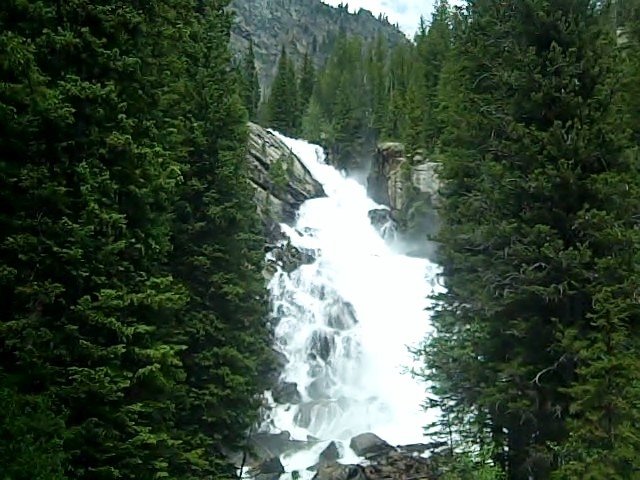
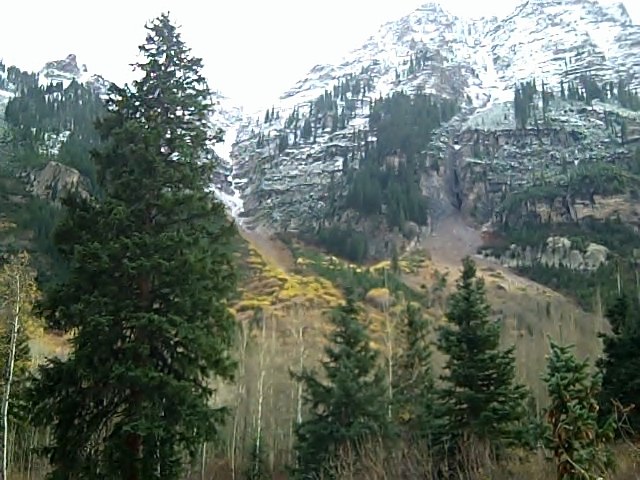
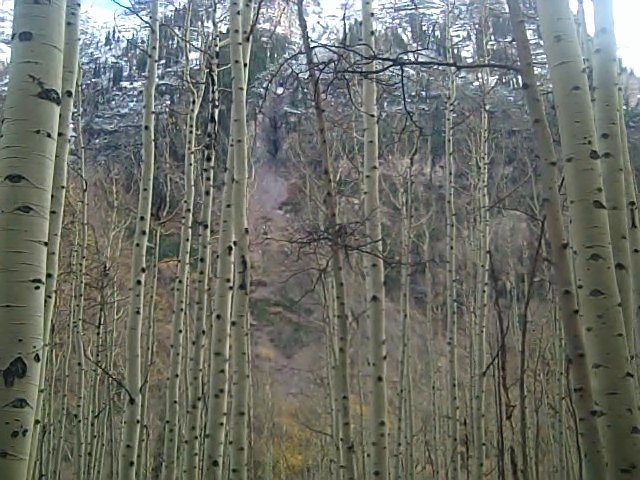
I live in Canada but I am addicted to this UK canal narrow boat YouTube channel:
https://www.youtube.com/channel/UC6SNxiLzSlh8e0yjndE9o_A
Seeing the photo of the River Wharfe (Wetherby) reminded me of that. What a great resource you guys have in your country.
Seems like a nice retirement lifestyle to me (or a good way to save up for the property ladder if you live near London).
It's great the you got to see the forests in the States. I have been to Colorado USA and Vancouver Island here in Canada. Amazing places and great forests.
Trees dating up to 34 million year? Simply Amazing! Well written article.
Thank you!
Hell of an article this. I love trees and walk through them every day. The leaves are growing now and spring is here
Thank you!
I've become enamored with @lesshorrible's #nsas initiative and have pledged to pick my weekly favorite #nsas post and sponsor the author for a share of #steembasicincome.
All the posts this week were high quality, but yours really stood out because your interweaving of personal stories and science made it particularly engaging, so congratulations on being the first one sponsored.
For what it's worth, the smokies are definitely worth the trip.
Wow, that's quite an honor. Thank you. I will be on the road for a few more days and not posting much. Let me know if you need me to do anything?
There's nothing you have to do. You should start seeing a small upvote from one of the SBI accounts on every post you now make for life.
Thanks for taking this topic up David! You wrote it perfectly. So glad you incorporated The Redwood variety in your post as they are my favorite types of tree. One forest I suggest you visit is the Ancient Bristle Cone Pine forest. I find it ironic, we have been deforesting the largest carbon dump on the planet for decades and only now are complaining of global warming.
Thank you. Yes I would love to see the Ancient Bristlecone Pine Forest in California.
I am also amazed with the beauty of the forests. Cities are very crowded and polluted that's why I usually go to mountain resorts to chill and appreciate nature. Very well written @davidrhodes124

Thank you!